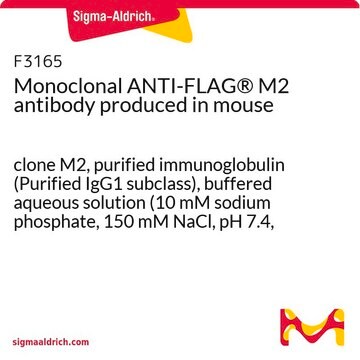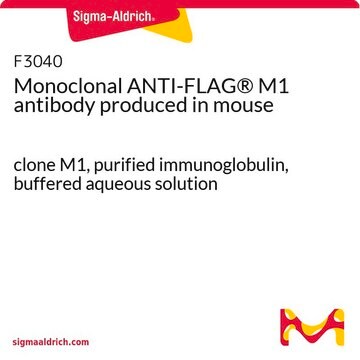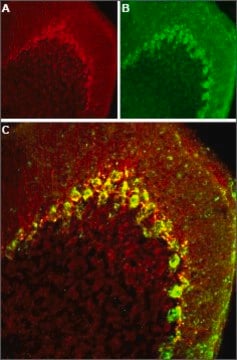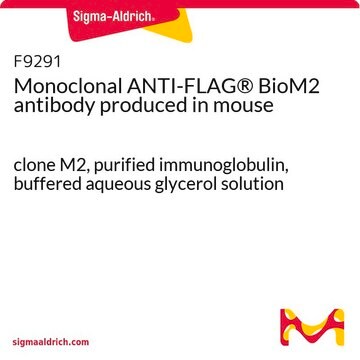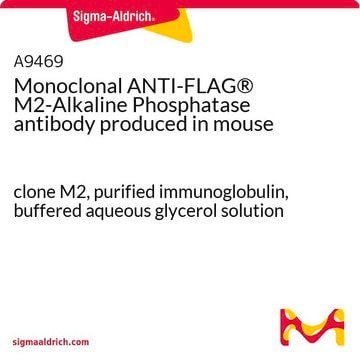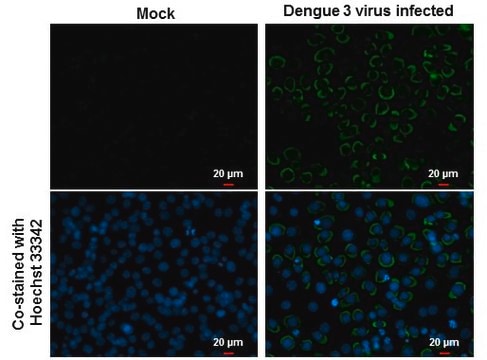Kluczowe dokumenty
SAB4200071
ANTI-FLAG® antibody, Rat monoclonal
clone 6F7, purified from hybridoma cell culture
Synonim(y):
Anti-ddddk, Anti-dykddddk
About This Item
Polecane produkty
pochodzenie biologiczne
rat
białko sprzężone
unconjugated
forma przeciwciała
purified from hybridoma cell culture
purified immunoglobulin
rodzaj przeciwciała
primary antibodies
klon
6F7, monoclonal
Formularz
buffered aqueous solution
reaktywność gatunkowa
all
metody
immunoprecipitation (IP): 2.5-5.0 μg using lysates of transiently transfected cells expressing C-terminal-FLAG-tagged protein
western blot: 0.5-1.0 μg/mL using extracts of transiently transfected cells expressing C-terminal-FLAG-tagged protein
izotyp
IgG1
sekwencja immunogenna
(DYKDDDDK)
Warunki transportu
dry ice
temp. przechowywania
−20°C
Opis ogólny
Monoclonal Anti-FLAG® recognizes N-terminal,
C-terminal and internal Flag-tagged fusion proteins. The product is especially recommended for identifying C-terminal FLAG®-tagged fusion proteins.
Epitope tags provide a method to localize gene products in a variety of cell types, study the topology of proteins and protein complexes, identify associated proteins, and characterize newly identified, low abundance, or poorly immunogenic proteins when protein specific antibodies are not available. Tagging with the FLAG® peptide sequence may be done at the N-terminus, N-terminus preceded by a methionine residue, C-terminus, or at internal positions of the target protein. FLAG may also be placed in associationith other tags. The small size of the FLAG® tag or sequence and its high hydrophilicity tend to decrease the possibility of interference with the protein expression, proteolytic maturation, antigenicity, and function.
The N-terminal FLAG® peptide sequence contains a unique enterokinase cleavage site allowing it to be completely removed from the purified fusion proteins. Cleavage of the C-terminal FLAG® peptide from a fusion protein catalyzed by Cu2+ ions has been reported. A sequence motif with five out of eight amino acid residues identical to the FLAG peptide is found in both rat and mouse Mg2+dependent protein b-phosphatase, as well as in the human and bovine enzyme.
Immunogen
DYKDDDDK
Zastosowanie
- chromatin immunoprecipitation (ChIP)
- western blotting
- coimmunoprecipitation
- flow cytometric analysis
Postać fizyczna
Informacje prawne
Nie możesz znaleźć właściwego produktu?
Wypróbuj nasz Narzędzie selektora produktów.
Kod klasy składowania
10 - Combustible liquids
Temperatura zapłonu (°F)
Not applicable
Temperatura zapłonu (°C)
Not applicable
Wybierz jedną z najnowszych wersji:
Certyfikaty analizy (CoA)
Nie widzisz odpowiedniej wersji?
Jeśli potrzebujesz konkretnej wersji, możesz wyszukać konkretny certyfikat według numeru partii lub serii.
Masz już ten produkt?
Dokumenty związane z niedawno zakupionymi produktami zostały zamieszczone w Bibliotece dokumentów.
Klienci oglądali również te produkty
Nasz zespół naukowców ma doświadczenie we wszystkich obszarach badań, w tym w naukach przyrodniczych, materiałoznawstwie, syntezie chemicznej, chromatografii, analityce i wielu innych dziedzinach.
Skontaktuj się z zespołem ds. pomocy technicznej